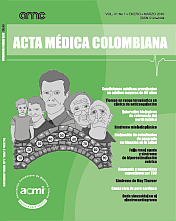Clinical characterization of patients with myelodysplastic syndrome
Abstract
Objective: to describe the clinical and socio-demographic haracteristics and quality of life of patients with myelodysplastic syndrome (MDS). Design: a descriptive cross-sectional study. Framework: Hospital San José de Bogota (fourth level institution). Population: thirty-nine patients diagnosed with MDS, older than 18 years, obtained in the statistics department. Main measurements: frequency of clinical and sociodemographic variables and quality of life measured by FACT-G scale. Results: the mean age was 74 years, with male predominance. The most frequent diagnosis was type mutilineage MDS dysplasia, and the most prevalent cytopenia was anemia. Most patients were classified as very low risk or low risk by IPSS-R and WPSS scale and low-risk and intermediate risk -1by IPSS and MDACC scale. Progression to acute myeloid leukemia occurred in 7.69%, while mortality occurred in 15.38%. There was a higher incidence of death and transformation to leukemia in patients classified as high risk. The quality of life was lower in patients with anemia and was higher in the MDS-(del5q). Conclusions: The characteristics of the study population are similar to those reported in the literature (predominantly in men, subtype of MDS more frequent, predominant cytopenia and risk distribution). There were differences with respect to age, frequency of comorbidities and their relationship to mortality. Quality of life was correlated with the subtype of MDS and cytopeniasMetrics
Metrics Loading ...
Published
2016-06-23
How to Cite
Mora Figueroa, G. E., Espinosa, D., Casas, C., Abello, V., & Solano, M. H. (2016). Clinical characterization of patients with myelodysplastic syndrome. Acta Médica Colombiana, 41(1), 36-41. https://doi.org/10.36104/amc.2016.538
Issue
Section
Original works
Acta Medica Colombiana uses the CC-BY 4.0 license. Authors retain all rights over their work.


